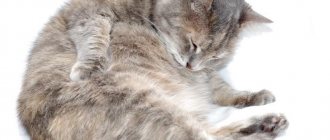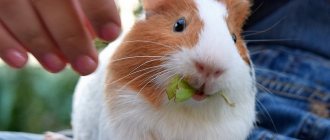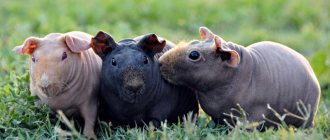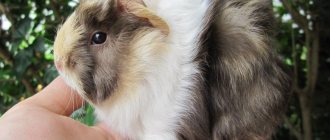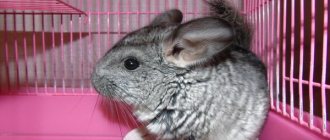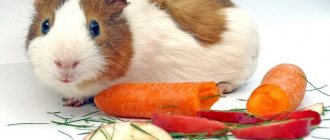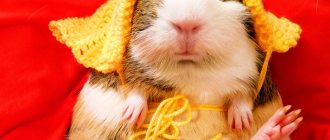What you need to know about guinea pig pregnancy. At what age do they give birth? What are the signs of pregnancy? How is pregnancy progressing? Proper care and feeding during pregnancy. How childbirth goes and what needs to be done. What care is required after childbirth.
Fluffy and very funny guinea pigs are gaining more and more attention and love among people. Of course, you want to have such a friendly and sweet creature at home, which, moreover, does not require a lot of attention. Increasingly, people are getting two animals of different sexes at once, so that further breeding is possible.
If you want to purchase a pair, you will first need to study in detail all the aspects of breeding, and also find out what kind of care a pregnant guinea pig requires so that there are no problems or difficulties in the process.
At what age do they give birth and how often?
These animals reach sexual maturity at a fairly early age. If we talk about the first mating, the best age is considered to be from 4 to 6 months.
The average duration of estrus is 16 days, but it should be borne in mind that there is a certain time period when the guinea pig is ready to mate and its duration is only 8 hours.
A female gives birth to 2-4 cubs. But soon she may again go into heat, in which she can also mate. Therefore, having cubs and feeding them, she may be pregnant with other offspring.
Puberty in rodents
An early first pregnancy is dangerous for a guinea pig. Although the female is ready to reproduce at the age of 2 months, her body is not yet strong enough to bear offspring and give birth to healthy cubs.
Veterinarians recommend waiting until the first mating. The ideal age to get pregnant for the first time is 11-12 months. Until this point, different-sex individuals are kept in different cages.
In males, puberty occurs 1-2 weeks later. At this age, the animal’s weight is 700-800 g.
How long does pregnancy last
If we talk about the pregnancy of all rodents, then guinea pigs have a longer period, up to 10 weeks. The average duration of pregnancy is 60-70 days, which can be influenced by several factors, such as the number of babies, fetal size and others.
It is worth saying that the duration, of course, is an individual indicator, for example, if a guinea pig bears 1-2 fetuses, then pregnancy can last up to 72 days, so there is no exact time frame for day-to-day millet.
Mating
For one male there should be from 5 to 10 female pigs. Some breeders keep them together, others separately - there is no fundamental difference. In the case of separate keeping, the female during estrus is placed in a cage with a “man”.
The hunt lasts about two days, the frequency of estrus is 13-20 days. The favorable period for fertilization lasts about 10 hours. The female takes a characteristic pose (she is motionless, her hind legs are apart, her croup is raised) and is ready to let her partner approach her.
How to understand that pregnancy has occurred
In the early stages, it will be quite difficult to understand that the pet is in an “interesting” position, since they look as usual. Moreover, if a person is a simple hobbyist and does not breed guinea pigs, it will be impossible to understand this in the early stages.
But at the same time, the longer the period, the more signs are observed, they manifest themselves in habits and behavior. Already in the second month, you can notice external changes in your pet. Next, we will take a closer look at what changes occur in the life of a pet. Photos will help you navigate better.
Green feed
This food for guinea pigs is the most healthy and natural. Your pet should eat fresh greens, rich in fiber and nutrients, to maintain normal functioning of the intestinal tract. Below is a list of herbs recommended for guinea pigs:
- cereal sprouts; spinach; lettuce leaves; clover; carrot tops; beet tops; dill, parsley, cilantro; plantain; yarrow; chamomile; dandelion leaves.
You need to be very careful when collecting grass for your pet. Among the useful plants there may be poisonous ones. Therefore, you should not put a bunch of grass in a cage without carefully sorting it out first. Fresh greens for your guinea pig should be thoroughly washed.
The most important food for guinea pigs. Hay not only normalizes the functioning of the intestinal tract, but is also an excellent tool for grinding down the incisors of rodents. Like grain, hay is sold at any pet store. When purchasing, it is important to carefully check that the dried grass is not affected by mold. Rotten and moldy hay can harm your pet's body. If the owner is engaged in the preparation of hay on his own, then he must carefully inspect the collected grass for the presence of prickly, weeds, and poisonous plants.
Behavior change
If you know your pet well and have often observed it, then you will notice changes in behavior immediately. The female moves less, one might say that she becomes lazy.
She tries to build herself a separate house, looks for a secluded corner and buries herself in the hay. Refusal of any treats may also occur. Can show aggression towards the male sex.
Signs and preparation for impending birth in a guinea pig
The owner calculates the approximate date of birth in advance (or consults a specialist) in order to monitor the process and provide assistance at the right time. Closer to the desired date, a nesting house is set up in the cage. You can use a regular box, lining the bottom with sawdust, hay, pieces of fabric or newspaper.
When the gestation period comes to an end, the female shows restlessness: she builds a nest and constantly washes herself. As a result, mobility decreases. She sits motionless next to the nest and consumes a lot of water.
The proximity of birth is determined by examining the pig's pelvis: after the 60th day of pregnancy, the pelvic joints will begin to expand and the birth canal will open. A dilatation of approximately 2 fingers wide means that birth will occur in the next 24 hours. During this period, the animal experiences increased thirst, accompanied by a refusal to eat.
As a special precaution, owners prepare in advance everything they need in case of a pathological birth: clean towels, milk replacer, disposable syringes.
Weight gain
Of course, your beloved pet will gain weight; by the time she gives birth, the female will double her weight. It is recommended to regularly weigh the expectant mother and record her weight to monitor her normal condition.
When weighing, you need to be as careful as possible so as not to harm either the pet or the fetus; carry them very carefully.
Additional sources of vitamins and minerals
Most of all, a guinea pig needs vitamin C. Ascorbic acid is not synthesized at all in the body of rodents of this species. Therefore, animals must daily absorb a significant amount of food saturated with vitamin C. Phylloquinone and B vitamins can be absorbed in the guinea pig’s body only after repeated consumption, that is, after the animal eats its own feces. Therefore, a rodent that eats droppings cannot be stopped.
Of the minerals, salts and calcium are especially important for guinea pigs. Therefore, it is recommended to buy mineral sticks for your pet at the pet store. It is also permissible to treat your rodent with fish oil and bone meal as useful supplements.
There must be a drinking bowl with fresh water in your pet's cage. An adult animal needs 250 ml of fluid per day, but a pregnant female needs a little more. It is recommended to buy a drinking bowl for your pet. In such a device, the water will not become dirty or spill.
It is advisable to give the rodent bottled or filtered water rather than boiled water. The owner must carefully ensure that dirt and debris do not get into the drinking bowl. By consuming contaminated water, your guinea pig can contract an infection.
How to care
The animal must be protected as much as possible from worries and stressful situations, and provided with the necessary care, which will protect against possible premature birth, as well as miscarriage.
To do this you will need:
- It is necessary to keep the female separately; as soon as you find out about pregnancy, you need to separate other animals. The best option would be to leave her in the cage, since this way she will feel calm and will not be stressed.
- The cage should be located in a place where direct sunlight does not reach. Also, the cage should not be exposed to a draft.
- You will need to clear the cage of excess equipment, namely, remove devices such as hammocks, swings, ladders and shelves, so as not to harm the offspring.
- These animals are quite timid and any noise can greatly frighten them, causing stress, so you should not scream or make noise.
- Also, bathing the animal will be a stressful situation, so this procedure should be excluded.
- Since the female’s belly becomes dry during this period and constantly increases in size, this often leads to the appearance of microcracks. To prevent this, the belly is lubricated with baby cream every day.
- At this time, contact with the animal should be minimized; if there are small children in the house, you need to explain to them that while the pig is not allowed to be picked up, it is forbidden to squeeze or squeeze it. You need to take it in extreme cases and do it as carefully as possible. Remember that it is important to provide her with a calm and comfortable and calm environment.
- If the animal feels well, you should be given the opportunity to walk around the room. They are very important to prevent the development of obesity.
- Be sure to ensure that there is clean and fresh water, and do not forget about feeding, which is increasing.
Offspring
Guinea pigs are born with their eyes open, their teeth are already formed, and there is delicate fur on their body. They are sensitive to cold, so the mother warms them with her body.
The weight of a newborn rodent is 50-100 g. Babies grow very quickly. Already on the 2-3rd day they try to eat from the feeder and begin to explore the world. After 21 days, boys and girls are placed in different cages.
This is interesting! Guinea pigs only have two nipples. Her milk is very rich and nutritious. Piglets drink it for 3 weeks, although from the second day of their life they can eat solid food.
Caring for piglets without a mother
If the mother pig died from complications, it is better to place the piglets with another nurse. Otherwise, you will have to feed the young animals on your own. Newborns are given formula or cream with 10% fat every 3 hours.
Feeding is done day and night. From the 2-3rd day of life, babies are placed in a cage with a bowl of oatmeal and finely chopped vegetables. In order for piglets to empty their intestines and bladder, it is necessary to massage their tummies after eating. This is usually done by a mother when she licks her babies.
With good care, your guinea pig's pregnancy will go well. During this important period, it is necessary to pay special attention to the nutrition and living conditions of the rodent. If you have any warning signs, you should contact your veterinarian.
What to feed
The diet plays an important role in the life of a pregnant female; the health and well-being of the mother and cubs depends on it; in addition, the full formation and growth of the fetus depends on food.
Animal food should contain a variety of vitamins and microelements. But remember that you cannot overfeed your pet, as this can lead to obesity; introduce more vegetables and fruits into the diet.
So, let's take a closer look at what the diet should be like:
- Granular feed. It is an excellent option because it contains the necessary nutrients. But you should never overfeed, be sure to read the instructions and do not increase the portions.
- Hay. It contains calcium and protein, which are so necessary for the proper development of the fetus, it should be available daily.
- Water. Be sure to change the water as often as possible; it is advisable to install several drinkers so that there is constant water.
- Vegetables. Vegetables are an excellent source of vitamins and minerals, and they don’t make you gain weight; give them carrots, cucumbers, corn, etc.
- Herbs. Another source of vitamins and microelements that are of great benefit, give the female clover leaves, parsley, and other herbs, but make sure the plants are fresh.
- Fruits. They can also be beneficial, but only if they are given rarely and in small quantities; they are more of a treat for the animal; you can treat him to an apple, strawberry, raspberry and other ripe and juicy fruits.
- Cottage cheese, milk. These products are very important for females during pregnancy; they are given once a week.
- Vitamin E. A very important element for the health of the female and cubs, it is found in wheat and oats, so you should make sure that they are in the diet.
- Vitamin C. Another important element that is found in food, there is a lot of it in tomato juice. Make the menu in such a way that it contains products containing this vitamin.
- Vitamins and minerals. Now there are special vitamin supplements, including for pregnant females, that provide the body with everything it needs. The veterinarian will help you choose the most suitable option.
Selection of animals for breeding
To get strong, healthier offspring, you need to wisely select a pair for your rodent. Only clinically healthy animals are allowed for breeding. Guinea pigs must meet the following parameters:
- be active, mobile;
- have beautiful shiny fur, clear eyes;
- be moderately well-fed;
- have excellent breed qualities.
Animals suffering from obesity, chronic, congenital pathologies, defects, exhausted, sick rodents are not suitable for breeding. The weight of the female before mating should not be less than 700 grams. The expectant mother must be absolutely healthy and in excellent physical shape.
It is also not recommended to mate females who have not given birth and are older than one year, since the ligaments lose elasticity and the birth of a guinea pig can end in failure.
In order for the offspring to be born strong, healthy, and viable, female guinea pigs should not give birth more than twice a year. Males can be bred 2–4 times a year. In case of uncontrolled use of males, females will remain uncovered.
The best period for breeding guinea pigs is mid-spring and early summer. At this time there is a lot of varied and healthy food for rodents.
A week before the planned mating, you need to supplement the rodents’ diet with food that is rich in proteins, essential amino acids, vitamins A, E, C. Feed the pig sprouted wheat and high-quality cereals. Supplement your diet with succulent food, herbs, vegetables, and fresh hay.
How does childbirth go?
They most often give birth at night because it is the quietest time. The birth process itself lasts approximately 1 hour, but in some cases the duration can be up to 6 hours.
During childbirth, the female sits and tilts her head forward. They often do not make any sounds, everything goes quietly, but the animal may squeak a little.
The cubs are born in a shell, which the mother tears off and then begins to lick her babies. Upon completion of childbirth, she eats the shell and then begins to feed her offspring.
Possible problems
Despite the naturalness of this process, which should be inherent in any female animal, some complications may arise during and after childbirth:
- The youth of the female. Pigs can be used for breeding when they have reached a weight of 500 g. However, quite often females purchased from pet stores that live in the same cages with males may already be pregnant. However, if they are small, they are not able to give birth and raise offspring on their own.
- The female refuses to rupture the membranes of newborns. If this is not done in time, the babies may suffocate. The owner must help by tearing the film around the muzzle and clearing the mucus from the mouth and nose. To restore breathing, the baby is held tightly in the hand and shaken vigorously. They are then dried with a soft cloth and placed close to a heat source, such as a bottle of warm water. An hour later, when he can move, he is placed next to his mother.
- Termination of labor. If the uterine contractions have stopped, and there are still fetuses in the uterus, it is imperative to take the female to a veterinarian. He will help you surgically remove them.
- Refusal to breastfeed. This happens quite rarely, but nothing can be done. In this situation, children will need to be artificially fed.
- Shy female. Sometimes females can be frightened of their children, even though she has already partially licked them. She screams loudly and runs away, but since the babies are cold, they follow their mother, scaring her even more. If nothing is done, they will die from hypothermia. In this situation, you need to remove the babies, and after a while start adding them one at a time, giving the mother time to sniff them. If all else fails, then the owner needs to feed.
- Lack of milk. A young female may not have enough milk to produce a litter that is too large. In this case, you need to find another female or help the animal do this. The most suitable milk composition is pig milk. To obtain additional energy, honey and vitamin drops are added to it.
As you can see, caring for a pregnant guinea pig is not difficult, but it has its own nuances. Knowing them, you can carry out childbirth without problems and also provide the necessary care for the offspring and the female.
What to do after childbirth
After the birth is completely over, and the mother has climbed out her babies, you need to completely clean the cage, you cannot touch the newborns. There are situations when dead cubs are born, they should be removed from the cage, since there are cases when the animal ate them, but this cannot be allowed.
Next, you will need to monitor your diet; the menu is not much different from what it was during pregnancy. You need greens and grass, vegetables, hay and granulated food, and be sure to ensure the availability of clean water.
For a month, the mother feeds the cubs with milk. It will not be superfluous to know that the cubs are born with teeth and can feed on their own, but under no circumstances separate them from their mother during the first month.
For full growth and development, they need breast milk, which cannot replace any food or supplements.
Make sure that both the female and the cubs can reach the feeders and drinkers. You will also need to arrange the cage in such a way that there is enough space for absolutely everyone. If necessary, you need to purchase a new home for a large family.
Caring for a pregnant pig
Guinea pig pregnancy is a very complex physiological process. A complete hormonal change occurs in the body, which leads to increased energy costs. Therefore, during this period, owners should be especially careful about their pregnant pet. The expectant mother should receive a varied, balanced diet, high-quality food, and proper and systematic care.
Feed should contain high concentrations of protein, vitamins, organic, essential acids (lecithin, tryptophan), macro- and microelements (phosphorus, calcium, magnesium, selenium). Give your rodent sprouted oats, wheat, various grains, roots and tubers.
The diet of a pregnant rodent should be nutritious and balanced
The volume of the diet is increased by 1/3 at the beginning of pregnancy and almost doubled at the end of pregnancy. There should always be fresh boiled water in the drinking bowl for drinking. In addition to water, the expectant mother can be given warm milk in small quantities.
There is no need to disturb a pregnant pig again. Stress negatively affects the condition of the guinea pig and weakens the body. If you pick up a female, do it very carefully. There is no need to disturb your pet once again with inspections or frequent cleanings.
It is advisable for the expectant mother to place the piglets in a separate cage during pregnancy, a week before giving birth, and also after birth. In this case, it is best to temporarily move the male or other females to another home. Males can cover the pig immediately after giving birth, which will negatively affect its condition.
Keep the feeders, drinkers, and cage hygiene clean. Three days before the expected date of birth, the rodent's home should be clean, ideally prepared for the birth of the babies. Use soft hay and scraps of paper as bedding. The female will build a birth nest from these materials.
If the pig quickly loses weight, becomes lethargic, apathetic, reluctant to eat, reacts poorly to external stimuli, or the condition of its fur has deteriorated, do not leave the condition of the rodent unattended. Contact and consult with a veterinarian or ratologist (rodent specialist). It is possible that the expectant mother suffers from toxicosis, which, as a rule, manifests itself in the last stages of pregnancy or immediately after childbirth.
